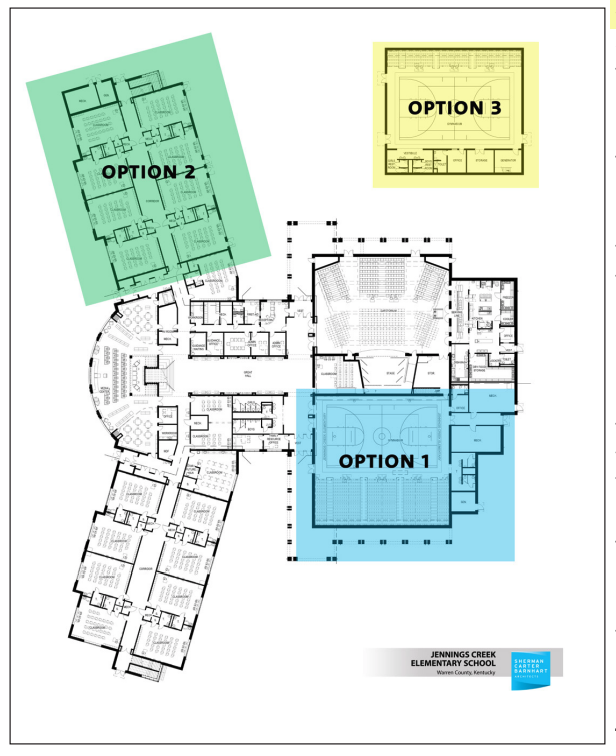 As we continue to research, gather pertinent data, and clarify our previous storm shelter requirements with the State Agencies of HBC and KDE, we wanted to provide a follow-up to “The Coming Storm” article. Specifically, we wanted to provide an example of how a recently completed school design could be modified to meet the storm shelter requirements and the projected cost of the modifications.
As we continue to research, gather pertinent data, and clarify our previous storm shelter requirements with the State Agencies of HBC and KDE, we wanted to provide a follow-up to “The Coming Storm” article. Specifically, we wanted to provide an example of how a recently completed school design could be modified to meet the storm shelter requirements and the projected cost of the modifications.
Jennings Creek Elementary School is a 750-student school that opened this year (August 2018). The building is a two-story, 93,000 square foot facility with a perimeter of insulated concrete forms and interior load-bearing masonry (concrete block). The roof consists of a TPO membrane on 6” rigid insulation and metal deck on steel bar joists. The design is an efficient, compact footprint and has the distinction of being Kentucky’s next net zero school.

In evaluating any storm shelter options, the first step is to determine the occupancy of the shelter and the amount of space required. It is NOT based on the student occupancy derived from the KDE model program. Instead, per clarification from HBC, it is based on one student per 20 sq. ft. of area for the occupant load of the classrooms. For Jennings Creek, the educational occupancy area is 26,916 sq. ft. divided by 20, for a total of 1,346 occupants. The required, resulting shelter size is based on five square feet per person, for a total of 6,765 net square feet (including space for seven wheelchairs). Support spaces such as restrooms, mechanical rooms, and an emergency generator enclosure will add approximately 1,000 sf for a total gross area of 7,765 sf.
With the shelter size now calculated for the Jennings Creek school, we can now explore several options that utilize program spaces within the building to serve as both educational space and storm shelter or build a standalone shelter, on the existing campus.
There are other significant building code requirements for storm shelters that have additional cost implications, regardless of their location in or adjacent to the school.
They can be summed up as follows:
• The shelter will be required to hold occupants for up to two hours with temporary ventilation, power, plumbing, and water, necessitating the addition of a generator (also protected from storm damage).
• The shelter will be required to have a two-hour fire barrier, with all doors fire rated for 90 minutes plus 1CC500-2014 impact resistance rating. Any windows will be two-hour rated with impact
resistance or shutters with the same ratings. In a tornado event, it is not just potential wind damage, but also flying debris that poses a significant threat!
• The shelter must have a clear, usable floor area of five square feet per occupant. A space in the school designated for the shelter cannot be filled with equipment, tables, chairs, etc., unless large enough for the required clear area.
• The shelter must be capable of withstanding 250 mph wind speeds and pressure of a direct tornado strike, including debris impact. This will necessitate reinforced masonry or reinforced concrete for the walls as well as a reinforced roof structure.
• The shelter must include a restroom facility with a minimum of two water closets (three if over 500 occupants, four if over 1,000 occupants) and one sink
(two if over 1,000 occupants).
• The architect must include a quality assurance plan and submit to HBC extensive storm shelter design and compliance drawings to document design compliance.
• A third-party peer review of the design will be required, meaning the design professional responsible for the shelter design will be required to hire another separate architect or MEP engineer to review the documents.
• Additional special inspections and structural observations specific to the storm shelter construction will be required, which will increase the cost of inspection services.
Based on the information we have to date and discussions with both HBC and KDE, we will explore the following three options to incorporate the storm shelter into the Jennings Creek School design.
Option 1 – In reviewing the Jennings Creek plan, the gym at 8,130 SF is sufficiently sized to accommodate the storm shelter capacity previously calculated (7,765 SF). A 2-hour fire barrier will be added to separate the gym from the rest of the school. Restrooms will need to be added (four water closets and two sinks), as well as three fire shutters and seven 90-minute impact resistant doors. A mechanical room with a generator will also need to be added to the protected structure.
The roof structure of the gym will be fortified to resist increased dead loads and wind uplift and the metal deck will be replaced with hollow core concrete planks. The 12” insulated concrete walls are already appropriate for the shelter, but additional rebar (reinforcing steel) will be added. The mechanical and electrical modifications will consist of a 1,000-gallon domestic water storage tank with booster pump and buffer tanks, a 3,000 cfm ventilation fan with motorized dampers interconnected to existing ductwork, intake and exhaust louvers meeting ICC500 impact requirements,
and a diesel generator with automatic transfers and panelboards in a fortified, adjacent room. The projected added cost to designate the gym as the tornado shelter will be $1,052,974.
Option 2 – In reviewing other spaces in the Jennings Creek design, a cluster of eight classrooms plus the corridor would give a combined area of 7,800 square feet, enough to satisfy the tornado shelter space requirements, even taking into account the furnishings typical in each classroom. Because standard classrooms are required to have windows, eight fire shutters will be needed, as well as 10 doors (90-minute fire and impact rated). A two-hour fire separation wall will need to be added to separate the classroom cluster from the rest of the school and also need to be carried horizontally to separate the shelter space from the second floor. The floor structure above the designated shelter will need to be fortified to 10” hollow core concrete planks (with a 2” concrete topping), and the ICF walls will have additional reinforcing steel. In this scenario, the concrete block corridor walls will need to be grouted solid (each cell) with additional rebar (reinforcing steel). The existing restrooms already in the Jennings Creek design can serve the toilet and sink requirements for the shelter. So there are some inherent savings as a result of this design. The electrical and mechanical modifications will consist of a new added mechanical room, a 1,000-gallon domestic water storage tank with booster pump and buffer tanks, a 3,000 cfm ventilation fan with motorized dampers interconnected to existing ductwork, intake and exhaust louvers meeting 1cc 500 impact requirements, and a diesel generator with automatic transfers and panelboards in a fortified, adjacent room. The projected added cost to designate the eight classroom cluster as the tornado shelter will be $823,483.
Option 3 – As previously discussed, a third option is to build a standalone tornado shelter on the school site. The Department of Education (KDE) is aware of the code changes and the potential financial burden the storm shelter requirement will place on new school projects. For now, the best practice is to incorporate the storm shelter within the KDE program space for the building.
KDE will, however, be reviewing each new school design and the subsequent inclusion of the storm shelter requirement on a “case by case” basis. Because of this, the proposed storm shelter in this option will also be an auxiliary gymnasium. The area required, with restrooms and mechanical / generator, is 7,765 square feet. Using the same fortifications – 12” reinforced ICF wall system and hollow core planks on reinforced steel joists for the roof structure and the same MEP modifications, the projected cost for the standalone auxiliary gym / storm shelter is $1,769,414.
In conclusion, one of the biggest challenges in meeting the new storm shelter code for school districts is the obvious added cost to school projects. While there are multiple design solutions to successfully incorporate the storm shelter into new facilities, there is a significant added cost. Another issue, however, will be the question of equity. How can a new facility provide a tornado shelter, while other facilities in the district do not? Moreover, even if a district has the bonding capacity to add storm shelters at multiple sites, not all buildings will qualify for the added program space of an auxiliary gym utilizing a bondable funding source. Additionally, districts will have to determine “neighbor” access into the shelter. One possible avenue to explore in meeting these challenges is applying for Federal Grants to help offset the construction costs. In the near future, we will report on “Alternate” funding opportunities and continue to update our clients as information becomes available.
To download this article click here

